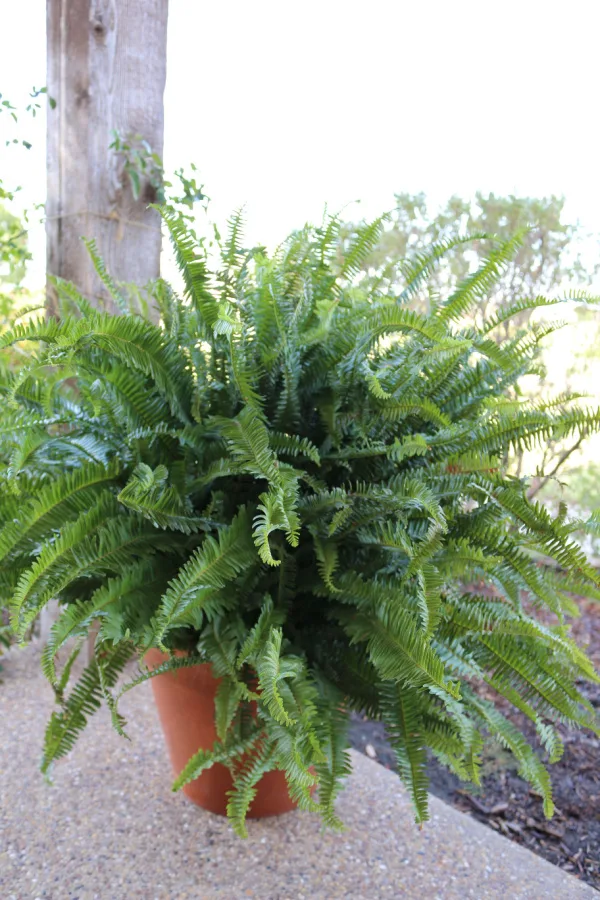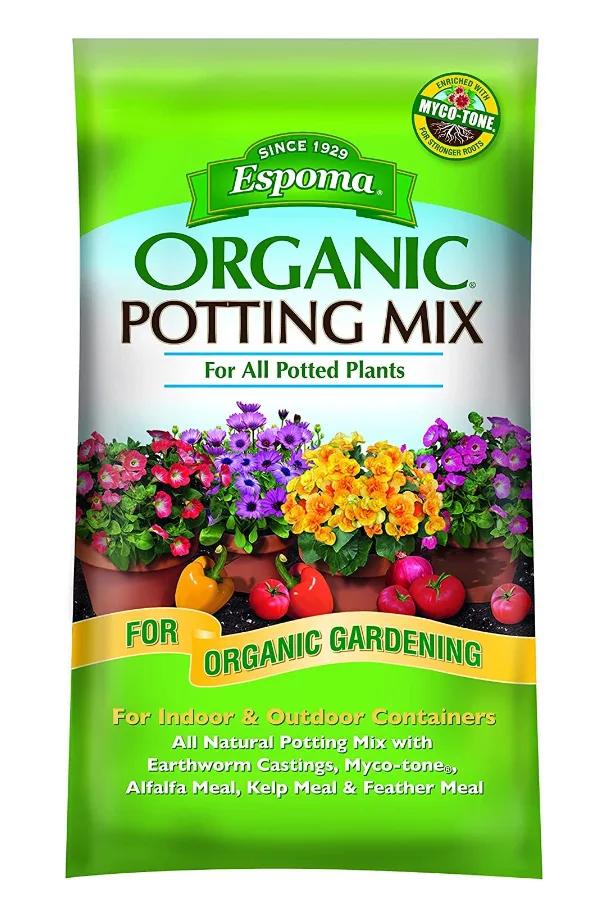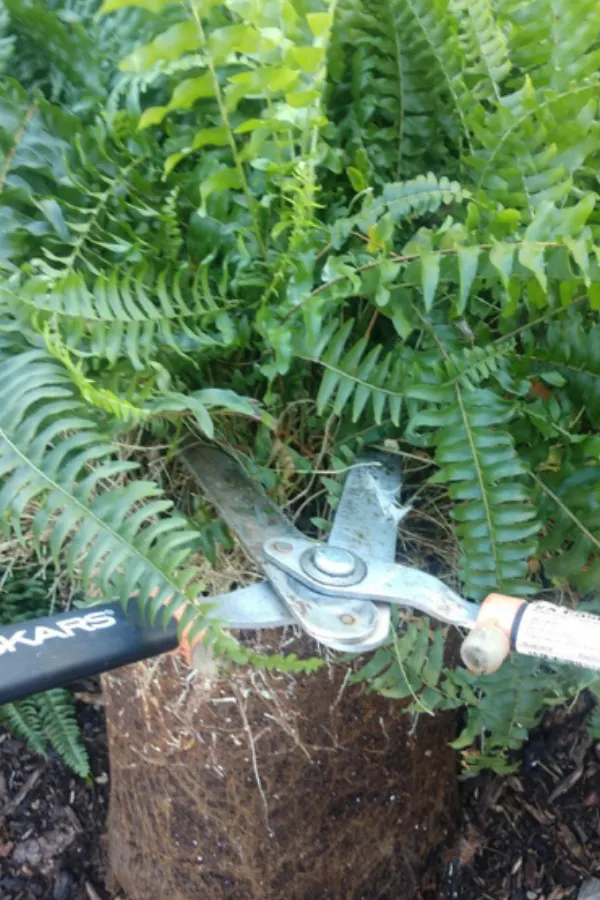If you are looking for a way to save your beautiful ferns that may have grown a little too large this summer – then fall is the perfect time to divide them into smaller new plants. Not only can you save your ferns to grow again next year, you can also have even more of them – and all for free!
Buying new ferns every spring can certainly get quite expensive. Especially when you need two, three or even more more to bring life to shaded patios, porches or decks.
But here’s the good news, by simply dividing your large ferns this fall into small new plants, you can create as many ferns as you need. And even better, you will never have to buy your ferns again!
Managing Overgrown Ferns – How To Divide Large Ferns In The Fall
One thing is for sure, it doesn’t take long for a fern to grow to enormous size. If a fern is placed in the proper location and is watered on a consistent basis, it’s going to thrive. Even without fertilizer and other additives, ferns grow well as long as they have their basic needs met.
In fact, with proper care, most ferns usually outgrow their containers in a single growing season. By late summer or early fall, not only has the fern foliage grown to enormous size, so have the roots in the container in which it grows.
Unfortunately, when this happens, many gardeners think it’s the end of the line for their monstrous plants. The thought of trying to overwinter such a massive plant indoors seems daunting at best. And even though you can cut the foliage back, the roots are still too compacted to perform well for another year.
But here’s the good news: by simply removing the fern from its container, cutting it back, and splitting its roots in smaller sections, you can create a slew of new plants. Plants that are not only easy to manage and overwinter indoors over the winter months, but can also grow to be gorgeous, full-grown ferns the following spring, summer and fall.

How To Divide Large Ferns In The Fall
Ferns can actually be divided at any point of the growing season. But by dividing in the early fall, you allow time for new roots to establish before bringing them indoors.
This has two big advantages. First, it sets the stage for the plants to come back quickly in the spring with strong, early growth. But even more, it allows for a much more manageable set of plants to overwinter inside.
Let’s face it – it’s hard to find space for massive ferns! But by cutting them back and splitting the plants into small transplants, you can keep them with little trouble. Even more, it eliminates the constant clean-up large ferns can bring as they drop many of their leaves over winter.
The Simple Steps To Dividing & Replanting Large Ferns In The Fall
The hardest part of dividing a massive fern can be dealing with all of the foliage. And the easiest way to combat that is by removing it before you ever start dividing!
Begin by using a sharp pair of hand held shears or hedge trimmers. Cut the fern’s fronds back two to three inches from the base of the plant. Cutting the plant back is usually much easier while the plant is still in its container.
Although many are a bit worried they will harm the plant by cutting it way back, it will not harm the plant in the least. Once you cut back the foliage, your fern will appear to be quite woody and bare. Again, this is completely normal.
Once the foliage is cut back, the next step is to remove the fern and root ball from the container. It will normally pull or fall out quite easily. This is usually because the plant is so root bound it has no ability to cling to the container.
Slicing The Plant Apart – How To Divide Large Ferns In The Fall
Once your fern is out of its container, place it on the ground and turn it over. You want the plant to be situated so that the bottom of the root ball is facing up. This little tip makes dividing so much easier to see the roots to get equal sections.
Create your new division by slicing down into the roots with a sharp shovel or knife. A Hori-Hori garden knife actually works great for this as it allows you to saw and slice easily down through the tough roots. Product Affiliate Link: Hori Hori Garden Knife
For most ferns that are growing in standard 8″ to 12″ pots, you can divide the root ball into four equal quarters. This will create four new plants that will be large enough to fill out an equal or larger size pot the following year.

If you are trying to create larger plants, you can opt to divide in half. This is a great option for planting into large pots to grow huge ferns. If you will be using containers or pots the following year on the smaller side, you can also opt to slice transplants into six or even eight sections.
Transplanting – How To Divide Large Ferns In The Fall
Now it’s time to transplant your divisions into their new pots! When transplanting into new containers, it is best if the new pot is bigger than the root ball but not too overly spacious.
For best results, select pots that are roughly 1/3 to 1/2 larger than the root ball. When ferns have too much space to roam, they will not keep their root ball in a tight formation. This can lead to plants drying out too quickly and poor root establishment.
For re-potting ferns, we like to use 12″ to 14″ pots. They are large enough to handle a year or two of growth, but not so big that the ferns have excessive soil area as they first grow. Product Link : 14″ self watering indoor / outdoor pots
Choosing Your Potting Soil – How To Divide Large Ferns In The Fall
One of the biggest mistakes gardeners make when repotting ferns is to use ordinary garden soil or heavy soil. When transplanting, it’s vital to use a high quality potting soil that is light and well draining.

Begin by filling the bottom of your planter with the potting soil mix. Next, sit the root ball cutting in the middle of the container. Once the transplant is level, begin to fill in around the side of the root ball with more potting mix. As you do lightly pack the soil with your hands to firm it into the root ball.
Finish by filling the remainder of the container with potting soil. Be sure to keep the surface of the fern’s cutting equal to the top of the soil level in the container.
Post Transplant Care – How To Divide Large Ferns In The Fall
One big advantage to dividing your plants in late summer or early fall is you can keep them outside for a bit to help them become established in their new home.
Keep plants watered as you would with your full grown ferns. Depending on the weather and the temperatures, it usually takes about 2 to 3 weeks to see new growth coming up from the roots and old foliage.
As the weather begins to turn cooler, it’s important to keep your ferns out of danger from the cold. That means when the threat of a frost or freeze is near, it’s time to bring them indoors for overwintering.
To overwinter your fern, select a cool room or area with indirect lighting. Basements with casement or basement windows are one of the best locations of all to overwinter ferns.
Watering Smart…
When overwintering, less is more when it comes to watering. Water only when the soil has dried out completely. Ferns will grow through the winter months, but in a very slow and limited fashion.
Once spring temperatures begin to warm, take your ferns outside to spur growth. Be sure to protect them or bring them back indoors when there is a threat of frost or freeze. You will be amazed at how quickly your ferns begin to fill out in the spring when they can go outdoors.
But perhaps best of all, you will have plenty of ferns to use for decorating – and all for free! Here is to dividing and transplanting your large ferns this fall. Happy Gardening! Jim and Mary.
Jim and Mary Competti have been writing gardening, DIY and recipe articles and books for over 15 years from their 46 acre Ohio farm. The two are frequent speakers on all things gardening and love to travel in their spare time.
As always, feel free to email us at thefarm@owgarden.com with comments, questions, or to simply say hello! You can sign up for our free email list in the subscribe now box in the middle of this article. Follow us on Facebook here : OWG Facebook. This article may contain affiliate links.



